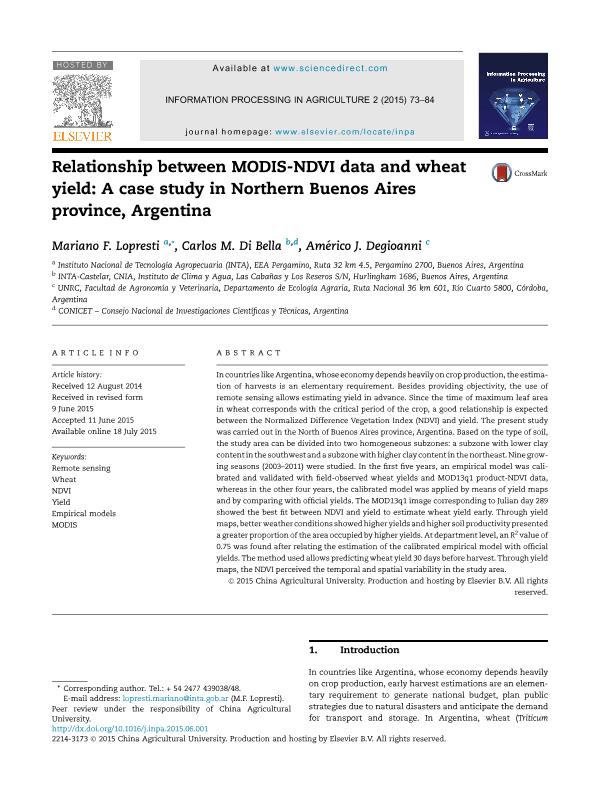Artículo
Relationship between MODIS-NDVI data and wheat yield: A case study in Northern Buenos Aires province, Argentina
Fecha de publicación:
09/2015
Editorial:
China Agricultural University
Revista:
Information Processing in Agriculture
ISSN:
2214-3173
Idioma:
Inglés
Tipo de recurso:
Artículo publicado
Clasificación temática:
Resumen
In countries like Argentina, whose economy depends heavily on crop production, the estimation of harvests is an elementary requirement. Besides providing objectivity, the use of remote sensing allows estimating yield in advance. Since the time of maximum leaf area in wheat corresponds with the critical period of the crop, a good relationship is expected between the Normalized Difference Vegetation Index (NDVI) and yield. The present study was carried out in the North of Buenos Aires province, Argentina. Based on the type of soil, the study area can be divided into two homogeneous subzones: a subzone with lower clay content in the southwest and a subzone with higher clay content in the northeast. Nine growing seasons (2003–2011) were studied. In the first five years, an empirical model was calibrated and validated with field-observed wheat yields and MOD13q1 product-NDVI data, whereas in the other four years, the calibrated model was applied by means of yield maps and by comparing with official yields. The MOD13q1 image corresponding to Julian day 289 showed the best fit between NDVI and yield to estimate wheat yield early. Through yield maps, better weather conditions showed higher yields and higher soil productivity presented a greater proportion of the area occupied by higher yields. At department level, an R2 value of 0.75 was found after relating the estimation of the calibrated empirical model with official yields. The method used allows predicting wheat yield 30 days before harvest. Through yield maps, the NDVI perceived the temporal and spatial variability in the study area.
Palabras clave:
Empirical Models
,
Modis
,
Ndvi
,
Remote Sensing
,
Wheat
,
Yield
Archivos asociados
Licencia
Identificadores
Colecciones
Articulos(SEDE CENTRAL)
Articulos de SEDE CENTRAL
Articulos de SEDE CENTRAL
Citación
Lopresti, Mariano F.; Di Bella, Carlos Marcelo; Degioanni, Americo; Relationship between MODIS-NDVI data and wheat yield: A case study in Northern Buenos Aires province, Argentina; China Agricultural University; Information Processing in Agriculture; 2; 2; 9-2015; 73-84
Compartir
Altmétricas




